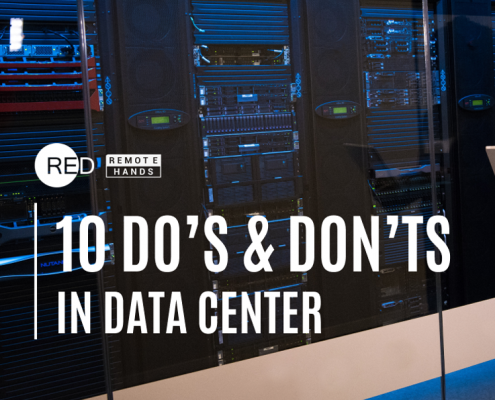
Do you know when a Data Center equipment goes down, how often it is down to human error? According to an Uptime survey, it was highlighted that human error contributes up to 70% of system downtime and costly security compromises. This result is surprising because most of the equipment and infrastructure within the Data Center is build and designed with multiple layers of redundancies and diversity, however with this said, as it stands today they are still maintained and supported by human resources.
Though it can be a challenging task to eliminate human error completely, it can be significantly reduced by following best practices and processes.
In Part 3 of the series on everything about Remote Hands, we will discuss some of the Do’s & Don’ts while working in such a critical environment. The list below is not exhaustive or technical but covers the basics and forms a starting point.
Part 3: Do’s & Don’ts In A Data Center
Do’s:
Possess Valid Induction Certificates:
Most Data Center have their own Health & Safety Induction Programs which are required to be completed before working in the facility in Data Centers. Data Centre owners should make sure one is in place and anyone working in the facility has a valid Induction and certification for whatever they are working on.
Comply To Secure Access Policies:
Data Centers are highly-secured environments with strict access protocols. They should be designed so that you can only access to areas that you are authorised to.
Perform Tasks Strictly Based On Tickets Received:
When undertaking Remote Hands work in a critical environment undertake services in line with the service request tickets. The ticket must provide all necessary information about the request. If unclear always ask and clarify before carrying out the task, this will remove any uncertainty and ambiguity. If possible do a pre-survey, this can eliminate the pressure of completing a job when everything isn’t clear or all supplies present, thus causing poor installations or mistakes.
Follow Standard Operating Procedure (SOP):
Why do you need an SOP? Remote Hands team must adhere to SOP at all times, to perform consistent quality work which can considerably reduce the chances of any human error.
Clean-Up And Ensure No Debris Is Left After Work:
3 C’s – Complete the task, Clean Up before you go, and Check that the rack is locked and nothing is left behind.
Don’ts
Do Not Touch Anything That Is Not Part Of Your Scope:
Do not touch anything which is not listed in the Remote Hands scope of work and service request ticket. Even if you notice something that is not right, do not try to fix it but report it instead and get further instructions.
Do Not Lean On The Rack
This may sound simple and obvious but may have a detrimental effect on the uptime of the systems.
The racks within the data center house all the major equipment and connectivities, some racks are more interconnected than others. Any unnecessary movement of the ‘live’ rack may cause some connections to come loose resulting in a service outage. Therefore, this should be strictly avoided since it can displace the rack from its position and can potentially cause outages.
Do Not Bring Any Food / Drinks Into The Data Hall:
Liquids pose a great risk for shorting out critical computer components. Do not bring any food/liquid items into the data hall.
Do Not Forget To Label:
Clear and accurate labeling is critical for future reference and identification of the systems especially in the event of an emergency. Labels need to be clear and obvious. Remote Hands team must take the time to agree with the customers on the labeling standards in advance.
Do Not Open Floor Tiles More Than What is Allowed in the Data Center:
If you need to carry out a task that requires you to open the raised floor tiles, where appropriate do not open more than 4 tiles at a time, always close the ones that are opened before opening any others.
In this article, we are just scraping the surface. Rules will differ from facility to facility and customer to customer. Agree them in advance and maintain an exhaustive list to train engineers.
Till then, stay safe & stay tuned for Part 4 of the series covering everything about Remote Hands.
Our Remote Hands team covers countries across the Asia Pacific and offers both Remote Hands as well as Smart Hands Services. Let us show you how we can assist you with all your remote projects and operations, while you focus on your core business. Contact us click here.
PS: If you missed our last series, Click on the link to read Part 2: How Smart is Remote Hands?




